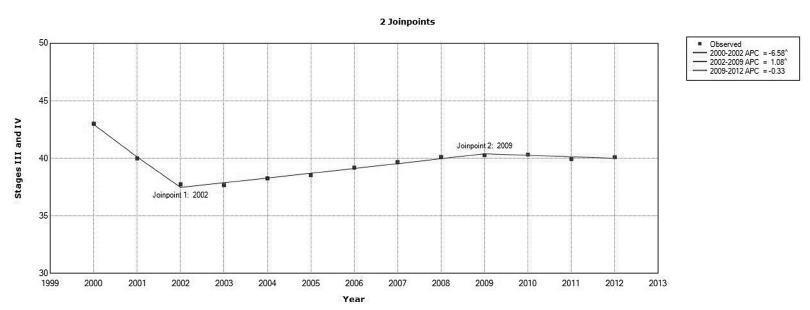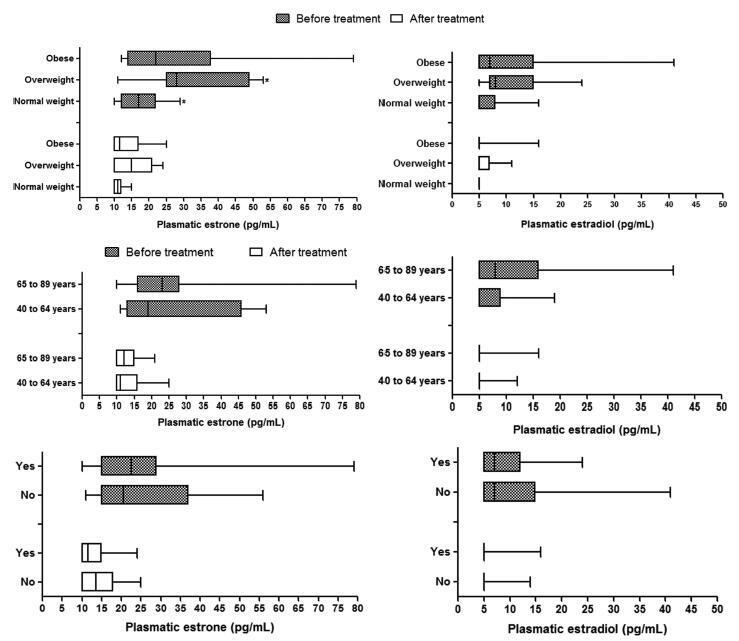Summary
Revista Brasileira de Ginecologia e Obstetrícia. 2020;42(12):820-828
To evaluate the distribution of the main sociodemographic and clinicalpathological characteristics in women with breast cancer according to the molecular profile by immunohistochemistry.
A cross-sectional, retrospective, analytical and quantitative study was performed, with an analysis of 137 medical records from January 2015 to December 2018 of women attending the High Complexity in Oncology Unit of the city of Imperatriz, state of Maranhão, Brazil. The immunohistochemical profile of tumors based on the estrogen and progesterone receptor, Human Epidermal growth factor Receptor-type 2 (HER2) overexpression and Ki67 cell proliferation indexwas defined, fromwhich six molecular subtypes were determined: luminal A, luminal B-HER2 negative, luminal B-HER2 positive, triple negative, overexpression of HER2 and inconclusive.
A total of 52.6% of the patients were postmenopausal, mean age 52.1 years old, brown (56.2%), had a schooling level < 9 years (40%), staging > IIB (52.6%) and 23.4% hadmetastasis. Invasive ductal carcinoma accounted for 84.7%, tumor size was 2 to 5 cm (48.9%), with lymph node involvement (56.2%), axillary lymphadenectomy in 67.2%, andmastectomy in 73.7% of the patients. Themost frequentmolecular subtype was the luminal B-HER2 negative (36.5%), and the luminal A subtype showed characteristics of better prognosis when compared with the others.
It was concluded that in the association of molecular subtypes with sociodemographic and clinical-pathological characteristics, there were no statistically significant results obtained, except for complementary therapy, referring to hormone therapy, and there was a high index of metastasis at diagnosis, which was a worrying factor and indicative of failures in the screening and early diagnosis of this population.
Summary
Revista Brasileira de Ginecologia e Obstetrícia. 2019;41(12):710-717
To identify the biomarkers of response to neoadjuvant chemotherapy in early luminal breast cancer.
A cross-sectional study that included all patients with early or locallyadvanced luminal breast cancer submitted to neoadjuvant chemotherapy between 2013 and 2014. Demographic, clinic and pathologic data were retrieved from patient records. The expressions of the estrogen receptor (ER), the progesterone receptor (PR), and Ki67 were analyzed by immunohistochemistry (IHC). The status of the human epidermal growth factor receptor 2 (HER2) was evaluated by IHC and fluorescent in situ hybridization (FISH). Independent predictors of clinic and pathologic response were evaluated by stepwise logistic regression models and receiver operating characteristic (ROC) curve analysis.
Out of 298 patients identified, 115 were included in the analysis. Clinical complete response (cCR) was observed in 43.4% of the patients (49/113), and pathologic complete response (pCR) was observed in 7.1% (8/115) of the patients. The independent predictors of cCR were premenopausal status (p < 0.001), low PR expression (≤ 50% versus > 50%; p = 0.048), and Ki67 expression ≥ 14% (versus < 14%; p = 0.01). Patients with cCR were more commonly submitted to breast conserving surgery (34.7% versus 7.8%; p < 0.001). Increasing cut-off points for Ki67 expression were associated with an increase in specificity and a decrease in sensitivity to identify patients with cCR.
Premenopausal status, lower PR expression and higher Ki67 expression were associated with a higher rate of cCR to neoadjuvant chemotherapy in luminal breast cancer.

Summary
Revista Brasileira de Ginecologia e Obstetrícia. 2018;40(12):794-799
Tamoxifen (TMX) is the main drug used both in pre and postmenopausal women as adjuvant treatment for hormone receptor-positive breast cancer. An important barrier to the use of TMXis the development ofdrug resistance causedby molecular processes related to genetic and epigenetic mechanisms, such as the actions of cytochrome P450 2D6 (CYP2D6) polymorphisms and of its metabolites. The present study aimed to review recent findings related to the impact of CYP2D6 polymorphisms and how they can affect the results of TMX in breast cancer treatment. The keywords CYP2D6, tamoxifen, and breast cancer were searched in the PubMed, Scopus, The Cochrane Library, Scielo, and Bireme databases. Studies related to other types of neoplasms or based on other isoenzymes from cytochrome P450, but not on CYP2D6, were excluded. The impact of CYP2D6 polymorphisms in the TMX resistance mechanism remains unclear. The CYP2D6 gene seems to contribute to decreasing the efficacy of TMX, while the main mechanism responsible for therapy failure, morbidity, and mortality is the progression of the disease.

Summary
Revista Brasileira de Ginecologia e Obstetrícia. 2018;40(4):203-208
To evaluate the prevalence of adherence to screening methods for breast and cervical cancer in patients attended at a university hospital and to investigate whether knowing someone with breast cancer, moreover belonging to the patient’s family, affects the adherence to the screening recommendations.
This was a cross-sectional and quantitative study. A structured interview was applied to a sample of 820 women, between 20 and 69 years old, who attended a university hospital in the city of Juiz de for a, MG, Brazil. For the analysis, the chi-square test was used to assess possible associations between the variables, and the significance level was set at p-value ≤ 0.05 for a confidence interval (CI) of 95%.
More than 95.0% of the sample performed mammography and cervical cytology exam; 62.9% reported knowing someone who has or had breast cancer, and this group was more likely to perform breast self-examination (64.9%; odds ratio [OR] 1.5; 95% CI 1.12-2.00), clinical breast examination (91.5%; OR 2.11; 95% CI 1.37-3.36), breast ultrasound (32.9%; OR 1.81, 95% CI 1.30-2.51), and to have had an appointment with a breast specialist (28.5%; OR 1.98, 95% CI 1.38-2.82).Women with family history of breast cancer showed higher propensity to perform breast self-examination (71.0%; OR 1.53 95% CI 1.04-2.26).
There was high adherence to the recommended screening practices; knowing someone with breast cancer might make women more sensitive to this issue as they were more likely to undergo methods which are not recommended for the screening of the general population, such as breast ultrasound and specialist consultation; family history is possibly an additional cause of concern.
Summary
Revista Brasileira de Ginecologia e Obstetrícia. 2018;40(3):127-136
To analyze the time trend and the factors regarding the diagnosis of latestage breast cancer in Brazil from 2000 to 2012.
We conducted a retrospective cohort study using data from hospital-based cancer registries. Joinpoint regression was used to analyze the time trends of stage at diagnosis. The risk of late-stage presentation was estimated using multinomial logistic regression.
A total of 170,757 cases were analyzed. The median time from diagnosis to treatment was of 43 days (range: 0-182 days). The percentage of cases with late-stage diagnosis decreased from2000 to 2002, with an annual percent change (APC) of -6.6%(95%confidence interval [95%CI]: -7.6--5.5%); it increased from 2002 until 2009, with an APC of 1.1% (95% CI: 0.9-1.3%), and remained stable up to 2012.Women with college education (compared with illiterate women) had less chance of having a late-stage diagnosis (odds ratio [OR]: 0.32; 95%CI: 0.29-0.35). The odds were greater among brown women (OR: 1.30; 95%CI: 1.21-1.41) and black women (OR: 1.63; 95%CI: 1.47-1.82), compared with white women. The odds were also higher for women treated in facilities located and in the Northern region of Brazil (OR: 1.23; 95%CI: 1.04-1.45) and in the Midwest (OR: 1.61;95%CI: 1.34-1.94), compared with those treated in the southern region of the country. Age, histological type, and marital status were some of the other factors that were positively related to staging at the diagnosis.
Access to diagnosis of breast cancer is uneven in Brazil, and women with lower socioeconomic status present a greater probability of having an advanced stage at diagnosis.

Summary
Revista Brasileira de Ginecologia e Obstetrícia. 2017;39(2):72-79
To evaluate the diagnostic accuracy of elastography for breast cancer identification in patients with indeterminate lesions on ultrasound.
This prospective, descriptive study included patients with indeterminate breast lesions in the ultrasound and with indication for percutaneous or surgical biopsy. The elastography was evaluated by qualitative analysis and by two methods for the semi quantitative analysis.
We evaluated 125 female patients with 159 lesions, with a mean age of 47 years, and a range of 20-85 years. Ultrasound has shown to be a method with good sensitivity (98.1%), but with a lower specificity (40.6%). On the elastography qualitative analysis, the specificity and accuracy were of 80.2% and 81.8% respectively. The mean size of the lesions showed no difference in classification by elastography. For the semiquantitative elastography, the mean values of the malignant lesions were statistically higher when compared with the subcutaneous tissue or the adjacent fibroglandular tissue. The analysis of the receiver operating characteristic (ROC) curves for these two semiquantitativemethods showed that both are considered satisfactory, with an area under the curve above 0.75 and statistical significance (p < 0.0001). The best results were obtained when using the findings of combined conventional ultrasound and qualitative elastography, with 100% sensitivity and 63.2% specificity.
Elastography can be a useful complementary method, increasing the specificity and diagnostic accuracy of conventional ultrasound for the diagnosis of breast cancer in patients with indeterminate breast lesions.

Summary
Revista Brasileira de Ginecologia e Obstetrícia. 2017;39(1):14-20
Obesity is associated with an increased risk for breast cancer. Recent studies have shown that aromatase inhibitors may be less effective in women with a high body mass index (BMI). The aim of this study was to establish the relationship between the BMI and plasma estrone and estradiol levels in postmenopausal women with hormone receptor-positive breast cancer using anastrozole.
In this cohort study, the patients were divided into three groups according to BMI (normal weight, overweight and obese) to compare and correlate plasma hormone levels before starting anastrozole hormone therapy and three months after treatment. Plasma hormone levels were compared for age and use of chemotherapy.
A statistically significant reduction in estrone and estradiol levels was observed between baseline and three months after starting the anastrozole treatment (p < 0.05). There was no statistically significant difference in plasma estrone and estradiol levels among the BMI groups (p > 0.05), but a significant reduction in plasma estrone levels was observed after three-months' treatment relative to baseline in all groups, as well as a reduction in estradiol in the obese group (p < 0.05). The use of chemotherapy and age > 65 years had no influence on plasma steroid levels.
Changes in estrone and estradiol levels in the studied groups were not associated with BMI, chemotherapy or age.
